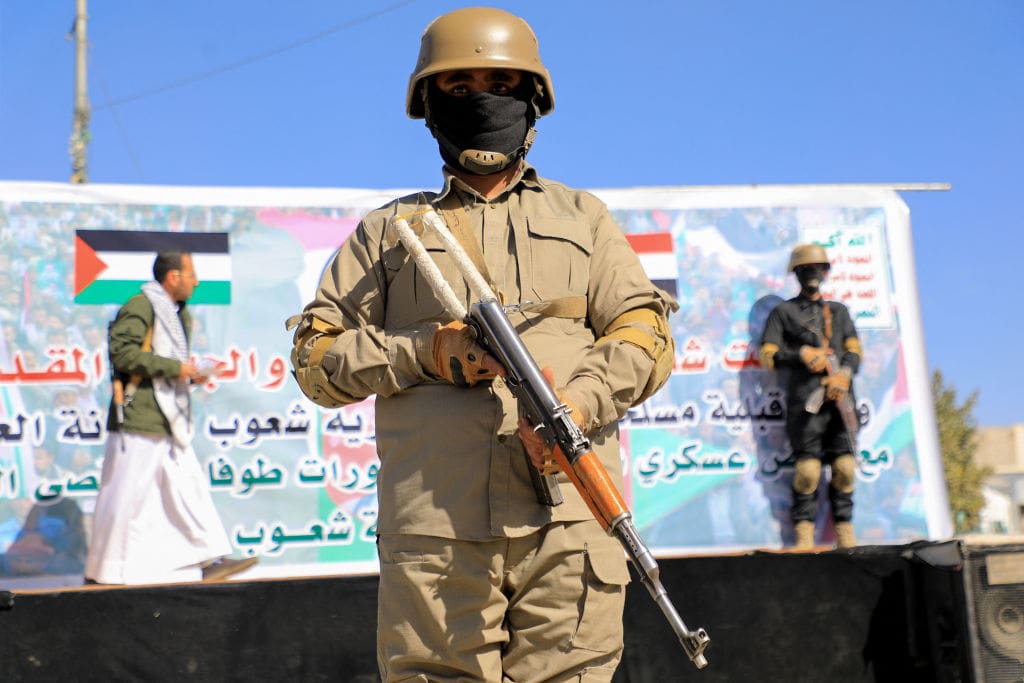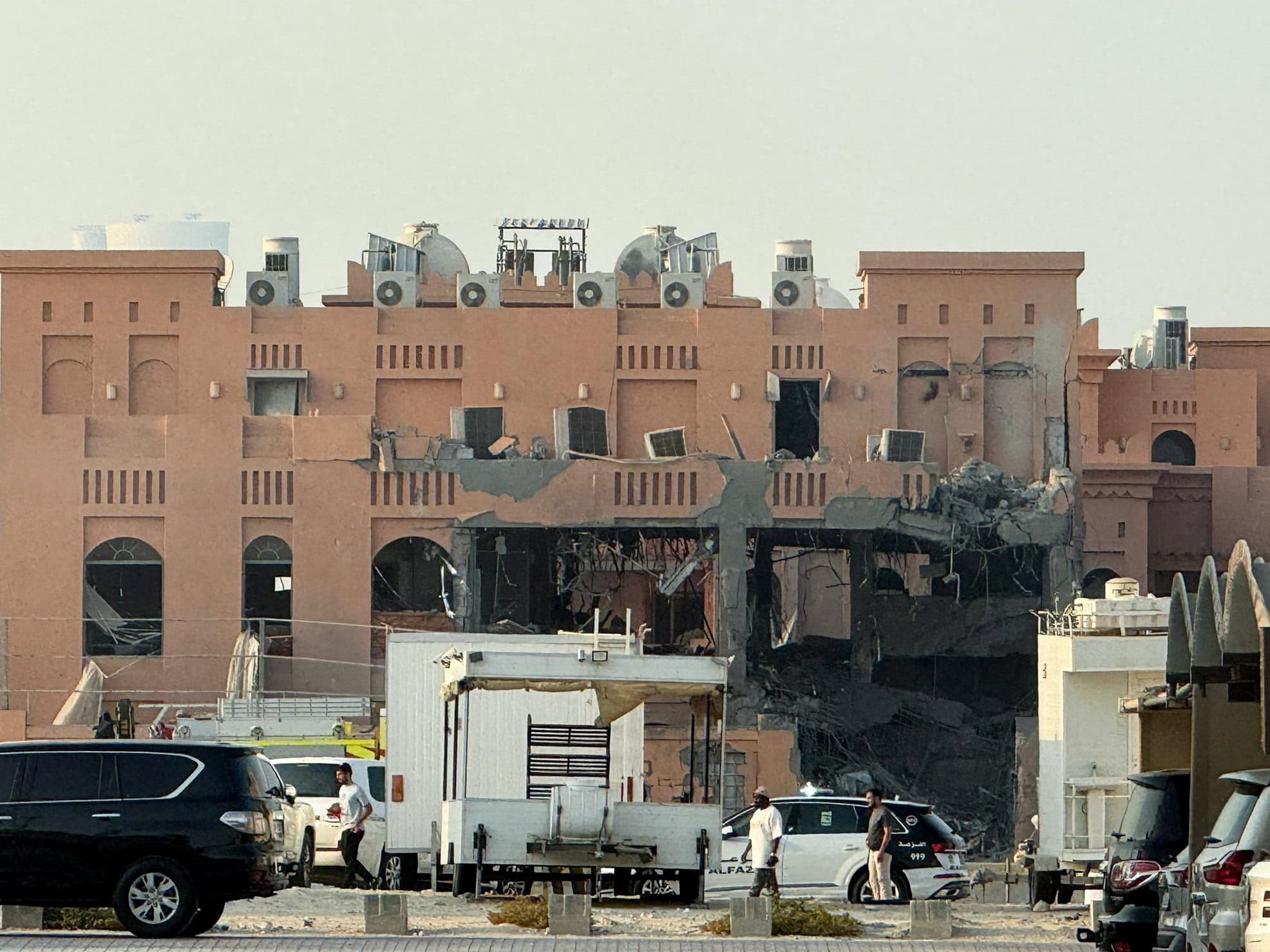
Yemeni Houthi-affiliated security forces stand guard during a protest in solidarity with the Palestinian people in the Yemeni capital Sanaa on 5 January 2024, amid the ongoing Israeli war on Gaza. [Getty]
آخر تحديث في: 12-01-2024 الساعة 7 مساءً بتوقيت عدن
Dr. Marta Furlan (South24 Center)
On January 12, the United States and Britain have launched military strikes in Yemen against the Iran-aligned Houthi rebels in response to the group’s attacks on shipping in the Red Sea. The strikes hit the al-Dailami air base north of Sana’a, the airport in Hodeidah, Kahlan base in Saada, the airport in Taiz, and military positions in Hajjah and Dhamar.
While the Western forces stated that no further actions are currently planned, fears of an escalating conflict in the region could hardly be higher.
Prior to the attack, Abdulmalik al-Houthi, the group’s supreme leader, warned in a televised speech that any US attack would not go un-responded. The group “would confront any American aggression” and their position “stems from our faith. The Americans should know what that means.” The Houthi spokesperson Yahya al-Saree also issued a warning to Western powers. After saying that the US and UK carried out 73 strikes that killed 5 and wounded 6 others of their forces, he termed the strikes as an act of aggression against his people and vowed that such actions would not go unpunished.
While the specific consequences were not detailed, the tone of Saree’s statement suggested a potential military retaliation. This could be continued strikes against ships transiting in the Red Sea, but also complex military operations against other targets, including US military infrastructure in the Gulf.
How it all started
Since the start of the Hamas-Israeli war, the Houthis have been asserting themselves on the regional scene as one of the most influential actors.
First, the group launched a series of missiles and drone attacks against Israel, targeting the city of Eilat in southern Israel. Following those attacks, whose value was mostly symbolic, the Houthis resorted to another much more consequential and much more disruptive strategy – attacking ships transiting through the Red Sea. While attacks seemed to be initially directed towards vessels associated (no matter how loosely) with Israel, the current reality is that passing through the Red Sea waters poses security risks also to ships with no clear link to Israel.
Far from being a localized regional matter, maritime security in the Red Sea is an issue of global concern. In fact, Western, Arab, and Asian countries depend on the Red Sea for commercial and energy trade. To understand the extent of the Red Sea’s importance to global trade, suffice it to think that 12% of global trade passes through the Red Sea, including 30% of global container traffic.
As many maritime shipping companies are rerouting their ships towards Africa and the Cape of Good Hope, thus revitalizing the continental circumnavigation route that used to connect Europe and Asia prior to the opening of Suez. As this forced re-routing has been raising considerably the times and prices of international shipping, the Houthis’ attacks have forced countries worldwide to face an unexpected cost of the Israeli-Hamas war.
Growing tensions in the Red Sea
In response to the security threat posed by the Houthis, the US sent additional warships to the region and sought to expand the Combined Task Force (CTF) 153. The new effort at maritime security was launched on December 19 under the name Operation Prosperity Guardian. As of the time of this writing, some of the nations that have been contributing in one way or another to this Operation include Britain, Bahrain, Greece, Norway, the Netherlands, and Denmark.
Two weeks after the launch of Operation Prosperity Guardian, helicopters from two US warships – the USS Eisenhower and USS Gravely – sunk three boats and killed 10 Houthi fighters, in what was the first major direct military engagement between the US military and Houthi fighters.
In a statement released after the incident, the Houthis - truthful to their traditional bellicose rhetoric - published an editorial under the headline “America has opened the door to hell for itself”, vowing revenge. This emboldened attitude was most evident on January 9, when the group launched one-way attack UAVs (OWA UAVs), anti-ship cruise missiles, and an anti-ship ballistic missile into the southern Red Sea, towards international shipping lanes where dozens of merchant vessels were transiting. This marked the 26th Houthi maritime attack.
How the latest attack affects the Houthis
As tensions in the Red Sea grow dramatically following the US-UK attack within Yemen, questions are raised on what will happen next.
The uncomfortable truth is that the Houthis seem to be navigating the current situation with ease. The Houthis see the military attack by the US and the UK as a golden opportunity to capitalize on the pro-Palestinian attitudes and the anti-foreign intervention sentiments that prevail in Yemen and recruit new sympathizers, supporters, and fighters.
Looking at what was the situation in Houthi-controlled northern Yemen before the Hamas-Israel war broke out, it is evident that this is also allowing the Houthis to divert attention away from a disastrous situation characterized by rising food and fuel prices, unpaid public salaries, widespread unemployment, lack of economic opportunities, and brutal suppression of dissent.
Besides, the latest Western attacks are seen by the Houthis as an opportunity to further consolidate their posture within the regional landscape and Iran’s Axis of Resistance, obtain more material support from Iran and its proxies, and acquire increasing visibility on the international and regional stage at the expense of the Yemeni legitimate government in the south.
As the world’s greatest military launches a strike against them, and the Houthis are de facto recognized as a force to reckon with, the Yemeni armed group promises to be emboldened further. For a group that has survived (and thrived in) eight years of bombing by the Saudis and whose leadership seems more comfortable navigating war than peace (their first military confrontation with the Yemeni government dates to 2004), this latest round of confrontation by the US and the UK is nothing but a reason for pride for the Houthis – and one that they will not be scared to respond to.
What the US and its allies will do then, is no easy dilemma to solve. Conduct more targeted strike against the Houthis’ limited and dispersed infrastructure in Yemen? Conduct larger strikes? And how to do so without sparking the regional conflict that the US is determined to avoid?
There are few good options for the US to deal with the Houthis at this stage. However, it does seem that it might be more beneficial for the US to refrain from approaching the current Houthi threat to maritime security as an isolated phenomenon, but rather to contextualize it in the wider Yemeni conflict. Specifically, the US and its allies should rethink the peace roadmap that was under way before the latest events and enhance support for the Yemeni legitimate government, which is the only actor that domestically can offer an alternative to the Houthis in the North.

قبل 3 أشهر

قبل 3 أشهر